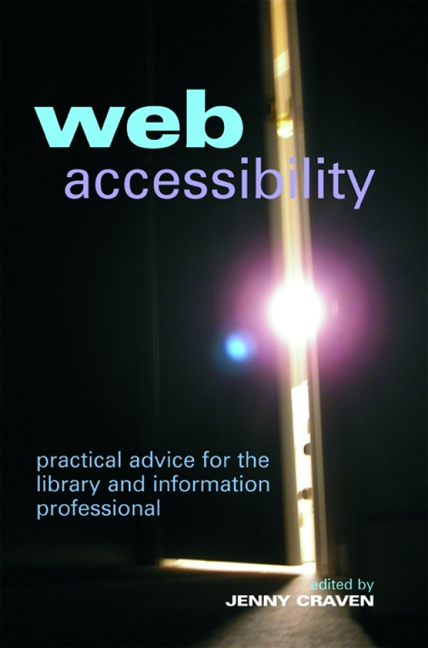Book contents
- Frontmatter
- Contents
- Contributors
- 1 Introduction
- 2 Tools used for widening access to the web
- 3 Design for All – how web accessibility affects different people
- 4 The importance of web accessibility
- 5 Accessibility advice and guidance
- 6 Accessibility evaluation and assessment
- 7 Issues for library and information services
- 8 Design for All in the library and information science curriculum
- 9 Best practice examples of web accessibility
- 10 Web accessibility in the future
- Index
3 - Design for All – how web accessibility affects different people
Published online by Cambridge University Press: 08 June 2018
- Frontmatter
- Contents
- Contributors
- 1 Introduction
- 2 Tools used for widening access to the web
- 3 Design for All – how web accessibility affects different people
- 4 The importance of web accessibility
- 5 Accessibility advice and guidance
- 6 Accessibility evaluation and assessment
- 7 Issues for library and information services
- 8 Design for All in the library and information science curriculum
- 9 Best practice examples of web accessibility
- 10 Web accessibility in the future
- Index
Summary
Introduction
The web, possibly more than any development since the discovery of electricity, has the potential to provide and liberate, but there exists also a responsibility for authors and designers to ensure it does not prevent and restrict.
There are a vast variety of types of website with many purposes and myriad audiences. All of these factors play a part in the actions that must be taken to ensure the site is as accessible as is relevant or achievable. A site may be simple or complex, textual or graphical. It may be for marketing or sharing, for information provision or information gathering. It may be for the general public or a subset of them, it may be for a known group of people with known characteristics. These factors must be determined before any consideration of accessibility can be made.
The increasing pervasiveness of ICT into the realm of the library and information professional offers an opportunity for increased engagement with a wider variety of users. In some instances the characteristics of these users are known and can be directly catered for, but in most cases the user audience is not known. The range of potential characteristics and needs across this largely unknown audience is therefore as great as within the general populace, and online resources must be designed and created with this factor very much in mind. This chapter will highlight the effects that good and poor practice can have on the user's experience.
What is ‘Design for All’?
In brief, ‘Design for All’ is the creation of a resource that is accessible to, and usable by, every member of the community for whose use it is intended. However, this very concept is a contentious one. Some would argue that ‘Design for All’ (along with its equivalent in common usage in North America ‘Universal Design’) simply means the creation of a single resource that can be accessed and effectively used by every person on the planet. Some would argue that the creation of a range of different resources, all of which are suitable for some users, and which reach all users when taken as a whole, also fits within the definition of ‘Design for All’.
- Type
- Chapter
- Information
- Web AccessibilityPractical Advice for the Library and Information Professional, pp. 25 - 40Publisher: FacetPrint publication year: 2008

